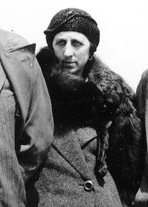Helga Karlsen

Helga Aleksandra Karlsen (20 November 1882 – 15 October 1936) was a Norwegian politician for the Labour Party, and the party's first female Member of Parliament.[1] Coming from humble origins, she gradually made her way up through the organisation of the labour movement. She served two non-consecutive periods in parliament (1927–30 and 1933–36), but died shortly before she could be elected for a third term. She has been called the Labour Party's foremost female politician in the interwar period.[2]
Early life and career[edit]
Karlsen was born in Oslo (at the time called Kristiania), to rail-road engineer Karl Arnesen (1860 – 1923) and Hilda Alette Torgersdatter (b. 1855).[3] It seems as though her mother died while Helga was still young, and the girl had to go into foster care; in early records she appears under the name of Helga Pettersen.[3] She started working at the age of fourteen, first as a maid, later in a café and in a candy factory. She then worked at a trading company for three years before entering into politics.[3]
Karlsen had been involved in the labour movement since she first joined their theatre group in 1899.[3] In the early 1920s, she was elected to the city council for the Labour Party.[2] Here, among other things, she argued against municipal funding for the building of the so-called Markus Church on Grünerløkka, on the basis of the acute shortage of housing in the city.[4] Karlsen was also deeply involved in the party's organisation of children's groups.[3]
Member of Parliament[edit]
In 1927 she was elected to Parliament as the first female representative of the Norwegian Labour Party.[a] It was during this period that she was fined the sum of NOK 500, for donating money to striking construction workers.[2] After a poor election for the party in 1930, she lost her position, but regained it in 1933.[3] In the meanwhile she was, as the first woman ever, elected chairman of Oslo Arbeidersamfunn (Oslo Workers' Society) in 1932.[2] In 1935 she participated at the International Labour Conference in Geneva, Switzerland.[1] Here she delivered a well-received speech in favour of the 40-hour week.[3]
In 1936, while running for a third term in Parliament, Karlsen fell ill. She was rarely unwell, but the busy schedule of the campaign had taken a great toll on her.[5] She died only four days before the election.[3] Karlsen was buried from the People's Houses in Oslo, where the eulogy was delivered by Martin Tranmæl.[5] She was survived by her husband, Fredrik Emanuel Karlsen (1873 – 1942), whom she had met through the labour movement.[3]
References[edit]
- ^ a b "Historiske bilder" (in Norwegian). Norwegian Labour Party. Retrieved 2009-08-26.
- ^ a b c d Staff. "Helga Aleksandra Karlsen". Store Norske Leksikon (in Norwegian). Retrieved 2009-08-26.
- ^ a b c d e f g h i Jensen, Lill-Ann. "Helga Karlsen". Norsk Biografisk Leksikon (in Norwegian). Retrieved 2009-08-26.
- ^ "Markus kirke" (in Norwegian). Norges Kommunistblad. 1924-12-20. Retrieved 2009-08-26.
- ^ a b Zachariassen, Aksel (1964). På forpost, Oslo arbeidersamfund 100 år, 1864-1964 (in Norwegian). Oslo: Oslo arbeidersamfund.
Further reading[edit]
- Syvertsen, Sigrid; Thina Thorleifsen (1960). Kvinner i strid : historien om Arbeiderpartiets kvinnebevegelse (in Norwegian). Oslo: Arbeidernes opplysningsforbund.
